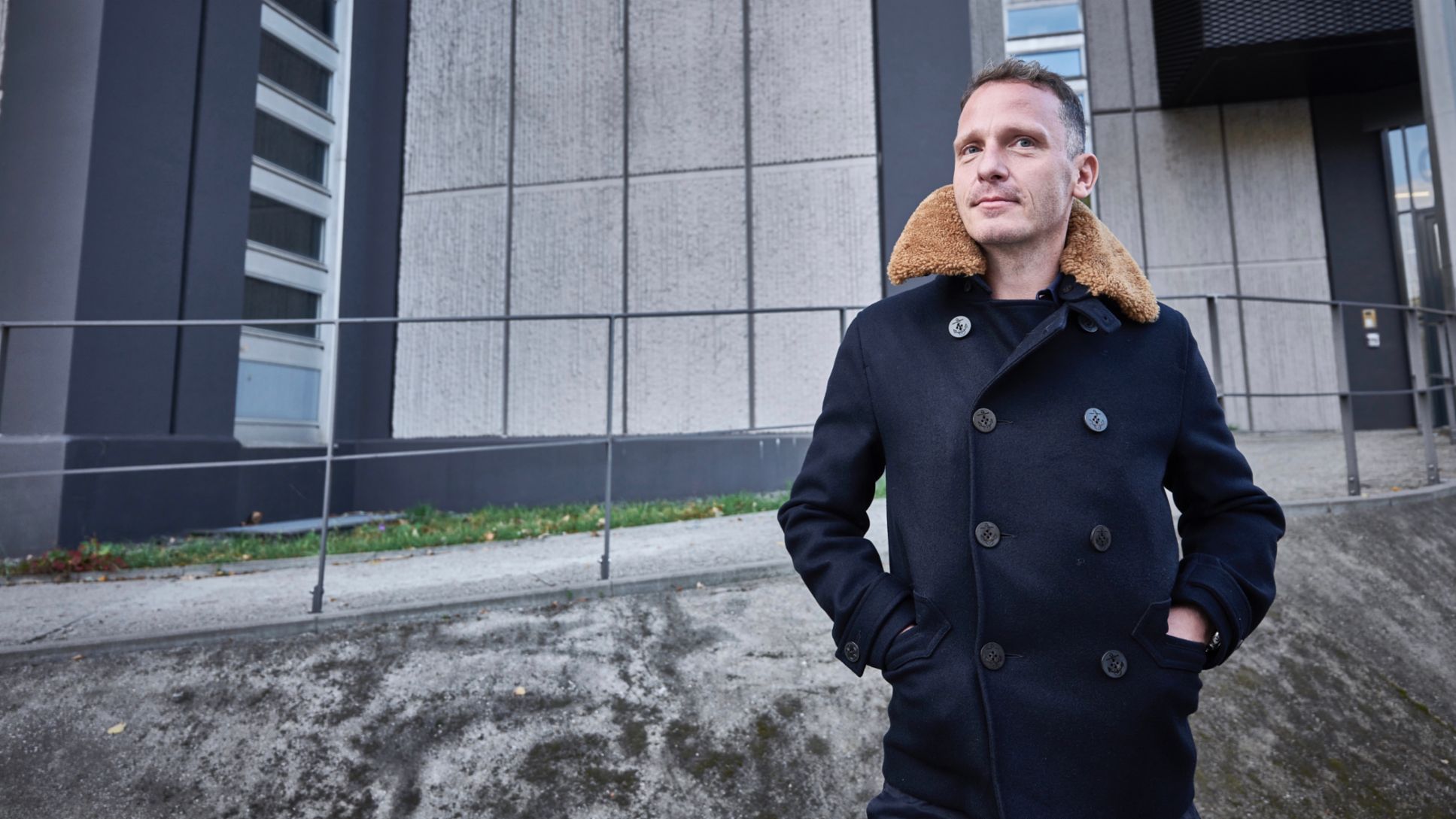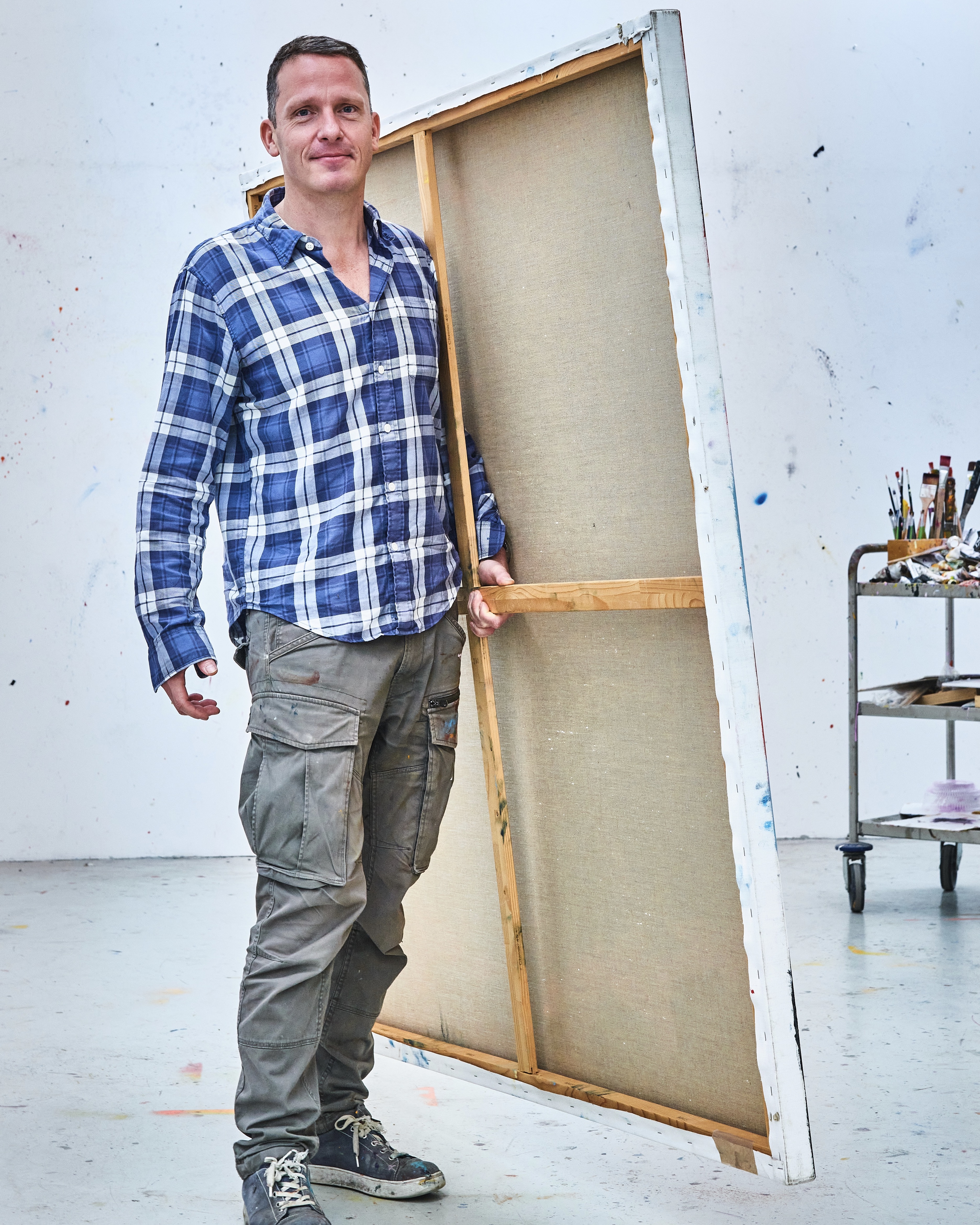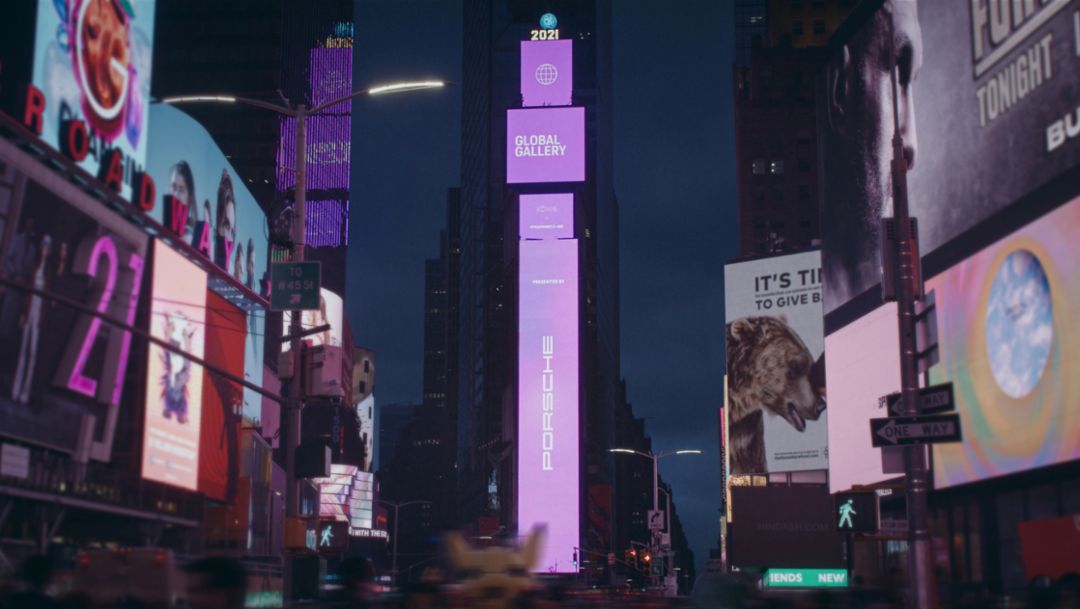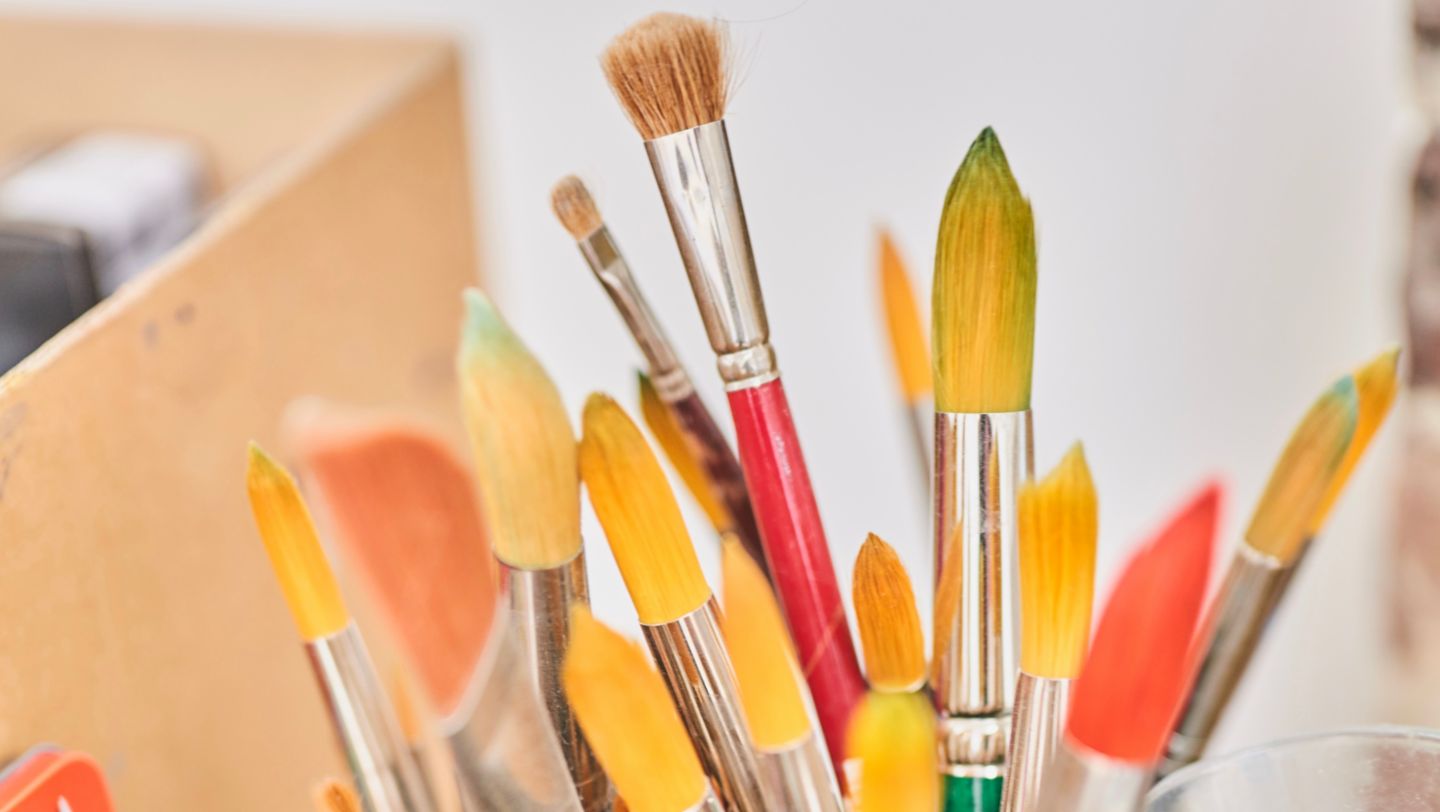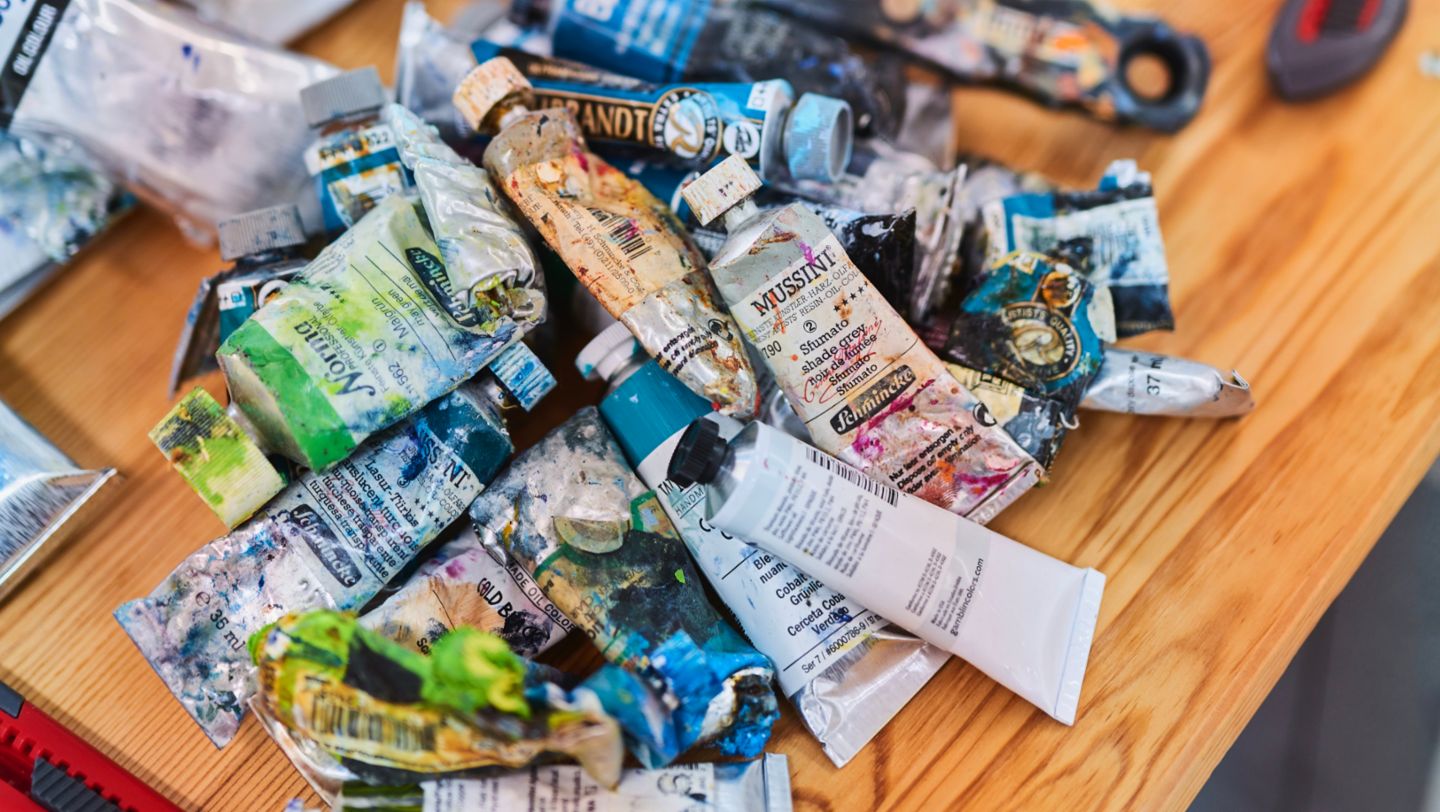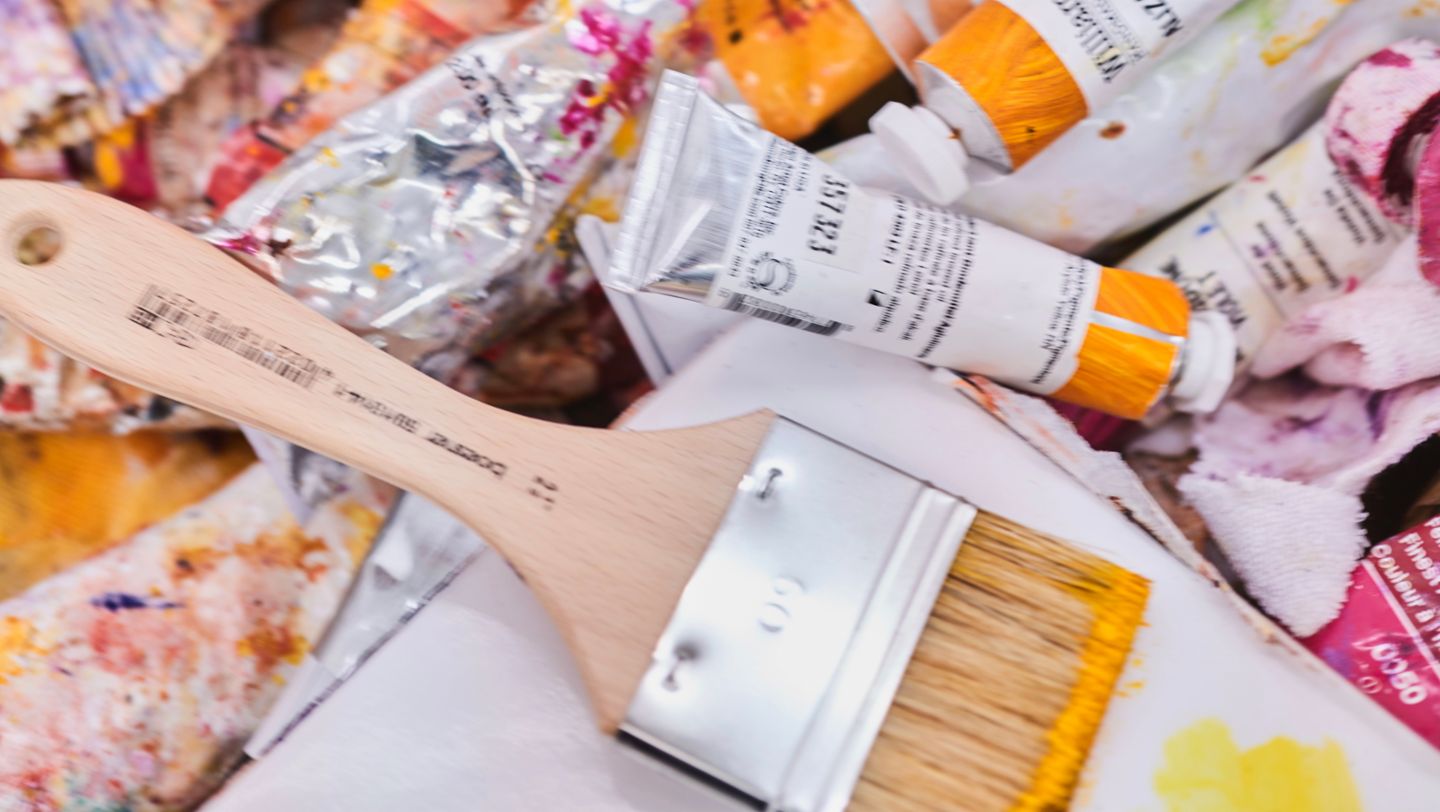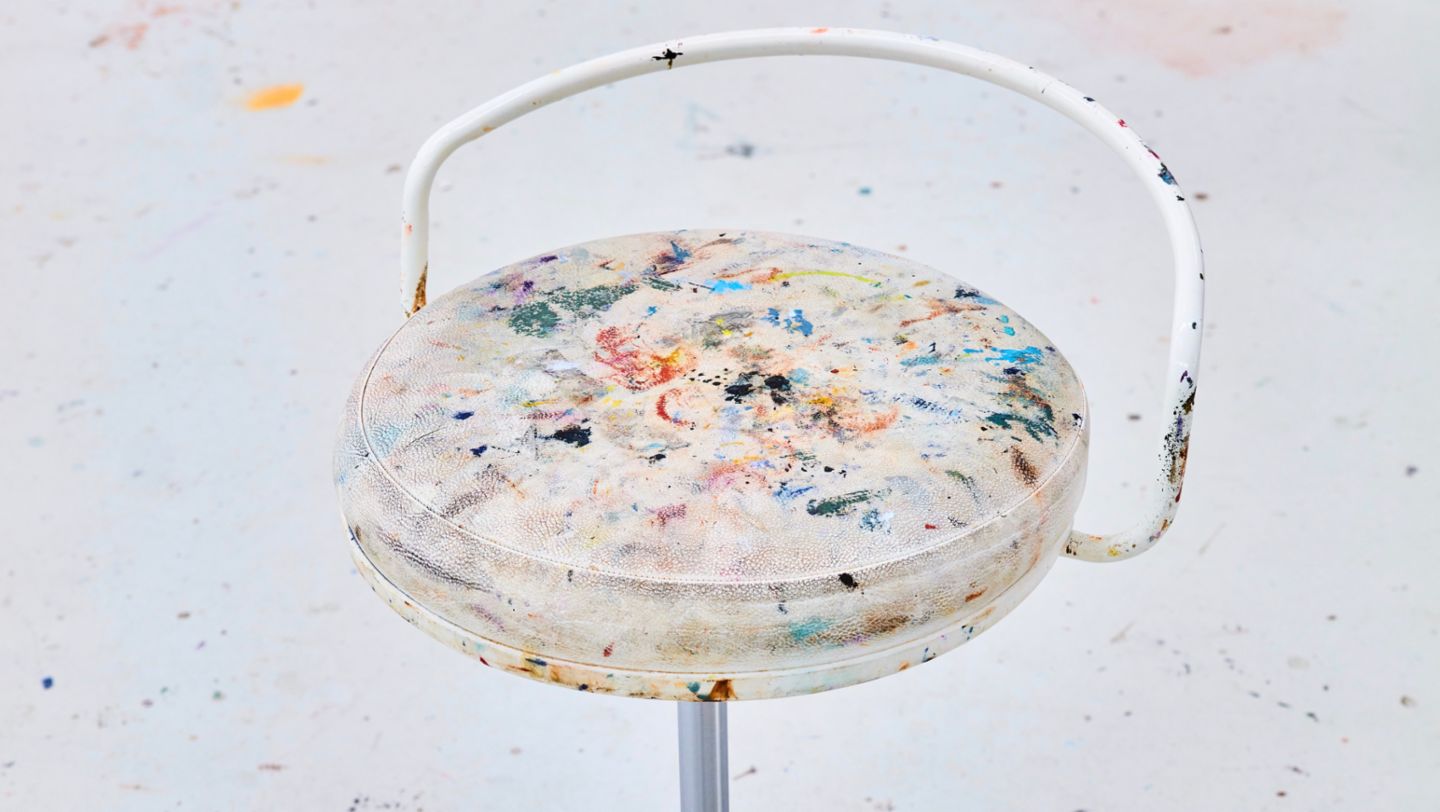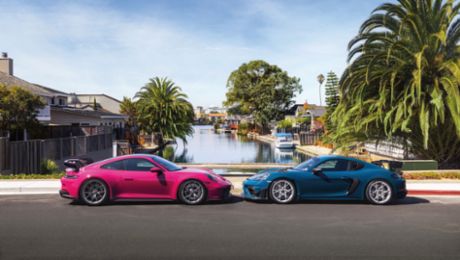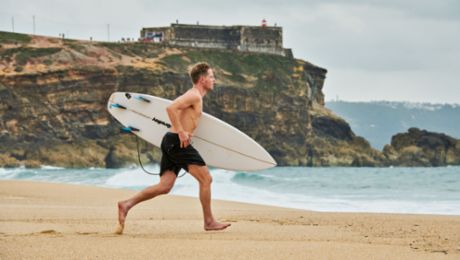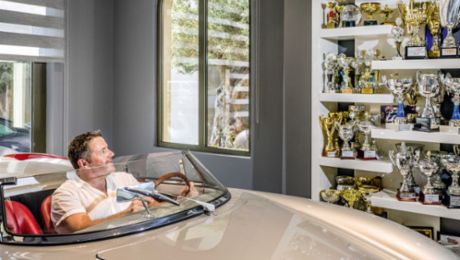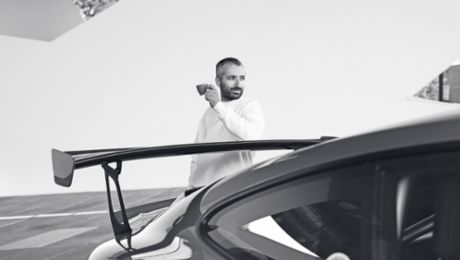A blond boy with tanned skin and a look of shock on his face. The landscape is barren, with individual trees in the background. A scene in watercolors: light green with lots of pink, white, and light. Nothing that could be classified as scary, if it weren’t for the line of men in uniform. The boy is looking into the barrels of four revolvers, surrounded by an idyllic landscape. Ich war’s nicht is the title of the picture painted by Norbert Bisky in 2003.
18 years later, the work of art is now on display in Leipzig. Bisky is showing his first solo exhibition in the city of his childhood, at the G2 gallery located in the former East German publicly owned data processing center. Looking much like an oversized server, the bulky concrete behemoth of a building is located in the heart of the city, just opposite St. Thomas Church and the former headquarters of the Ministry for State Security, East Germany’s infamous secret service, which is where the data from the data center would have been used. But before they could power up the server racks delivered in 1989, East Germany collapsed.
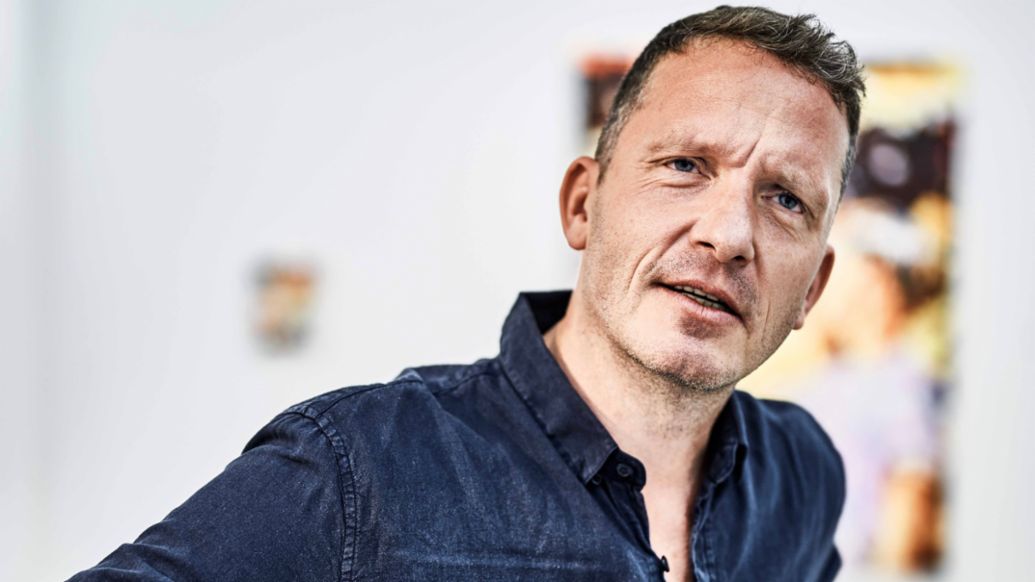
Once home to the servers, the building now houses Bisky’s paintings in bright colors. The painter stands smiling in the gallery, wearing a blue quilted jacket with fur collar and sneakers that boast red laces and are as colorful as his paintings. He actually had one of his pictures printed on the shoes, an idea developed by the painter in collaboration with a shoemaker and his curator. 250 pairs of them will soon be available for purchase. Artist merchandising and commerce – Bisky waves his hand: “It’s just a nice idea and an unbelievably comfortable shoe.” Then he turns his attention to the white rooms of the gallery, taking us on a tour of his works.
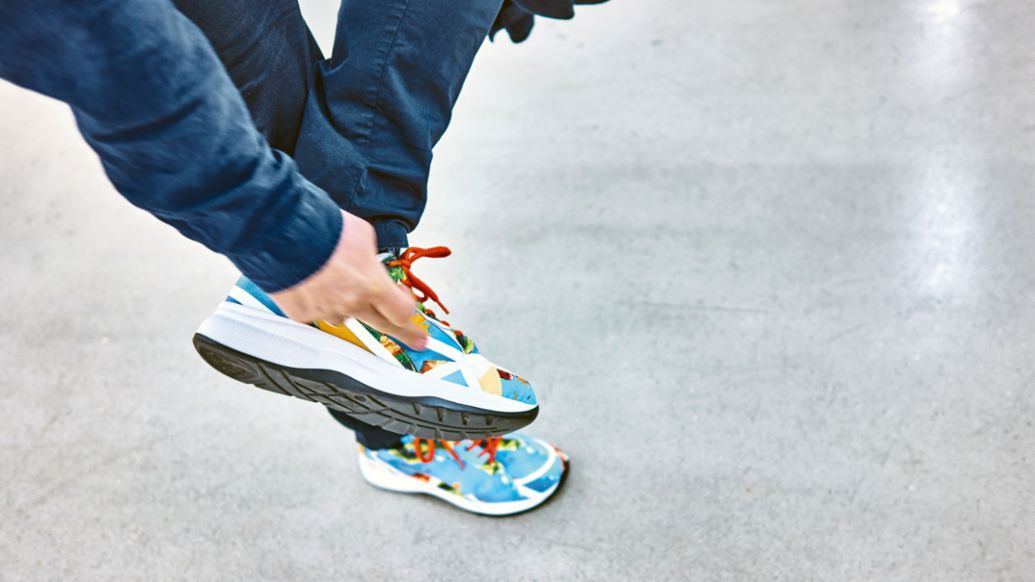
The Disinfotainment exhibition is an autobiographical journey, his life story on canvas, highlighting his artistic development, from delicate, sensitive watercolors depicting attractive people to monumental, dramatic worlds of images inspired by the present day. Bisky says he sometimes views his paintings as a sort of message in a bottle that people will find in a few decades, deciphering the messages it contains.
The piece Ich war’s nicht comes from a time when Bisky was processing his experiences in East Germany. He later says that the government robbed him of his youth. Norbert grew up the son of Lothar Bisky, the well-known left-wing politician and former President of the Film University Babelsberg. His brother Jens is a book author and journalist. Bisky says that artists were always treated with high esteem in his parents’ home.
At the beginning of his career, some critics accused him of glorifying a dictatorship with his bright colors and beautiful young men, while others suggested associations with Leni Riefenstahl, who was involved in the production of Nazi propaganda. Bisky felt misunderstood not only in terms of his life in East Germany, but also the way in which he processed it. With a lifelong spirit of defiance, he continued painting.
He browsed through newspapers and old textbooks “that had been disposed of by the thousands at schools and other institutions, but had also shaped people’s minds for decades.” He turned his attention to the things that were no longer useful to anyone. Deprived of their significance, they revealed details that no one had given much thought to, let alone dared to question. “Why did the uniforms of the People’s Police in East Germany look so much like those of the armed forces?” asks Bisky. East Germany had simply adopted the fashions of the former dictatorship – the uniforms of the fascists, just with the seams adjusted. Bisky talks about a “distressing aesthetic continuity.”
Paint, dry, package
For Bisky, his paintings are much like distant relatives. He rarely ever sees them once they leave his studio in the Berlin district of Friedrichshain. His artistic approach is: Paint. Dry. Package. “Then I turn my attention to the next painting.” He needs time and lots of Spanish coffee to work. “I sit in front of my paintings, walk around, and have to wait until they reveal what they want from me.” He’s always working on multiple paintings at the same time. As one is drying, he mixes the paints for the next picture.
Everything that’s finished has already been sold long ago and is then picked up. Norbert Bisky is a successful artist, which he refers to as “a dream come true.” It doesn’t bother him that people are willing to spend a great deal of money on his art. It doesn’t have any sort of effect on his work. “Buying art is never a bad thing,” he says. He thinks much the same about projects dedicated to promoting culture such as the Porsche program. “I don’t have any problems working with companies that are socially responsible and ensure that thousands of people have a good job and can live a good life. But there are also companies that I keep my distance from.” What’s important to him and just might be the consequence of the social upheaval he experienced: “I never want to be on the wrong side.”
For his most recent creations, Bisky cuts up painted canvases and reorganizes them on mirror surfaces, leaving space for a self-portrait of the observer.
In a spacious studio, Bisky stands ankle-deep in colorful shreds of canvas. Trying his hand at collages, he creates scenes by gluing strips of canvas onto mirrors. A response to narcissism in society and to people who always want to see themselves, even in the work of another. Taking this idea to a whole new level, his mirror pictures provide space for observers to see a self-portrait in the work – a painting with selfie function. These works are also an attempt to rediscover the art of painting time and time again. The mirror pictures, titled Mirror Society, can be seen in the SCAD Museum of Art in Savannah, in the US state of Georgia, until August 1.
Paintings in place of servers
He shows us some of these works in Leipzig, including Medienzeit, which represent a departure from his monumental paintings. Bisky is curating the exhibition himself. According to Anka Ziefer, curator of the G2 gallery, there are two types of artists: “Those who have many questions and look for help. And the others, like Norbert Bisky, whom you can entrust with the walls and who present themselves and their works as a monologue.”
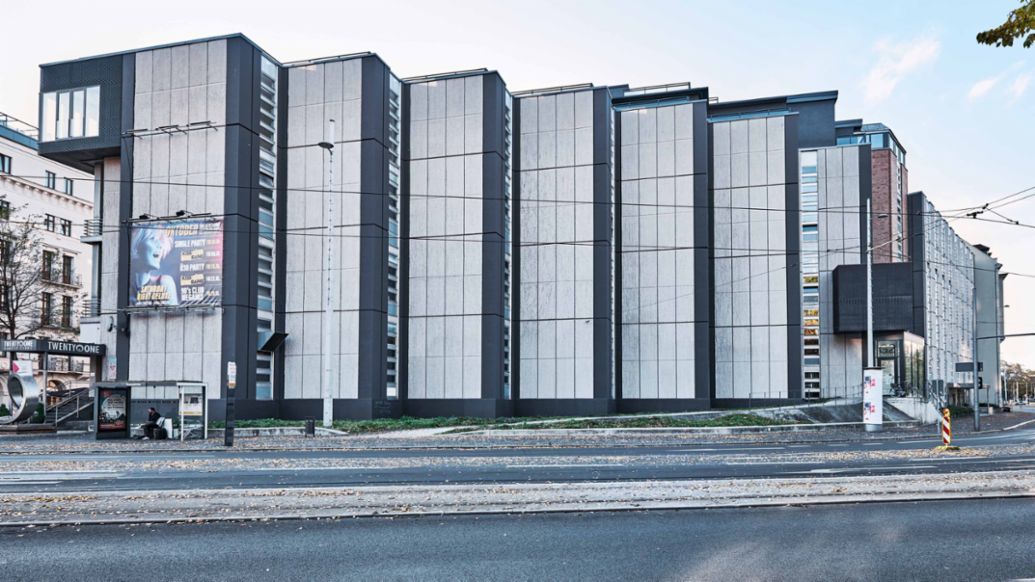
The building offers plenty of space for friction and creates references and links – a location without any memories, filled with purpose and now void of purpose. Art on the ground floor, a large dance club in the basement, and an upper floor with antique plaster casts. Bisky: “I quickly realized that I needed to do something here.”
With its unfinished story, this building is the best-possible backdrop for an issue that has concerned Bisky since the pandemic: communication in a world that, for many, is restricted to the computer. The faces of the people in pictures like the Follower painting are bathed in a special light, as if illuminated by a computer screen. “When they’re stuck at home, people reveal some of the most personal details,” says the artist. Information that not even State Security would have been able to access is now up for grabs. At the same time, the Internet exposes us to events all over the world. “Technology creates digital nonspaces. We’re able to witness everything everywhere and in real time. When else in history has that been possible?” Bisky can remember following the withdrawal of international troops from Afghanistan on the screen as he was painting by the Mediterranean Sea in summer 2021.
The scene of his childhood
His exhibition in Leipzig has been extended several times. Born in 1970, Bisky is a son of this city, having spent the first ten years of his life there. Leipzig had already left its mark on him by the time he learned to speak. He saw paintings for the first time at the Museum of Fine Arts, which is as much a part of his childhood as parks, gardens, and architecture. According to Bisky, the building he lived in in Waldstrassenviertel, the largest Gründerzeit district in Europe, was dripping with art nouveau. Bisky is well versed in the city’s unique vocabulary. “Where else does the waiter ask you if the meal was ‘to your satisfaction’?” For him, Leipzig has always been “the civilized, bourgeois urban alternative” to Berlin excess.
Bisky initially examined his experiences in East Germany with watercolors. His subsequent oil paintings are monumental and full of vibrant colors.
His journey into the world of art began in 1994 with his studies under Georg Baselitz at the Berlin University of the Arts. Born in 1938, Baselitz achieved fame with his figurative, expressive paintings particularly in the 1970s. It was also Baselitz who encouraged Bisky to examine his origins through his art, focusing on key questions: Who are you? Where do you come from? But that’s exactly what Bisky had been avoiding: “I wanted to forget my experiences in East Germany.” Ultimately giving in, he painted a picture inspired by his childhood – and hasn’t been able to let go of the topic ever since. Bisky first found his answers in watercolors, a technique that Bisky unfairly associates with amateurs. “On closer inspection, it looks so simple and banal. But everything that’s supposed to look simple is difficult. I like those kinds of contradictions.”
The watercolors he used to examine his East German past are almost playful; a fact he attributes to a deep longing for lightness, leisure, fun, and joy. “I didn’t have any of that when I was little. My time at school was nothing but propaganda, shaped by fear and pressure,” says Bisky, remembering back. Then suddenly in 1990 – during his basic military service in the National People’s Army – the wall came down, and East Germany simply ceased to exist. “The whole thing was so absurd,” says Bisky. Like many other young people in East Germany, he had to think about what he wanted to do with his life. Becoming an artist was out of the question. Even as a child, Bisky had always been interested in art, but how would he even go about becoming an artist? The teachers in East Germany had always dismissed thoughts like these, telling students to do what society needed them to. But what was that?
In Bisky’s opinion, talent is overrated. It’s the determination to use it that’s decisive.
In 1993, he submitted his application portfolio to the University of the Arts and completed the, in his words, laughable tests that were supposed to assess his talent. “The course is designed for people with extraordinary talent,” a quote that Bisky still makes fun of to this day. “If there’s something an artist doesn’t need, it’s talent,” he claims. “They need determination.”
But for Bisky, there’s something even more important: “Emotions are my work materials.” He takes them to a whole new level, especially in the Dies Irae piece completed in 2016. Measuring more than seven meters in length, the painting depicts apocalyptic scenes “in beautiful colors,” emphasizes Bisky, “like those you’d find at an Italian ice cream parlor.” People are tumbling through the air, a never-ending plummet. He was driven by a sense of instability: “Everyone was talking about the catastrophe, the climate, the environment – the balance was gone.” Embracing this instability, he painted individuals who are hurling through time. There’s no solid ground, and everything’s in motion. This also describes Norbert Bisky’s existence to this day: “I feel like I still have so much ahead of me – like I’m still just getting started with so many things. I will be an artist until my last breath.”
Info
Text first published in the Porsche magazine Christophorus, No. 402.
Author: Dirk Böttcher
Photograph: Anatol Kotte
